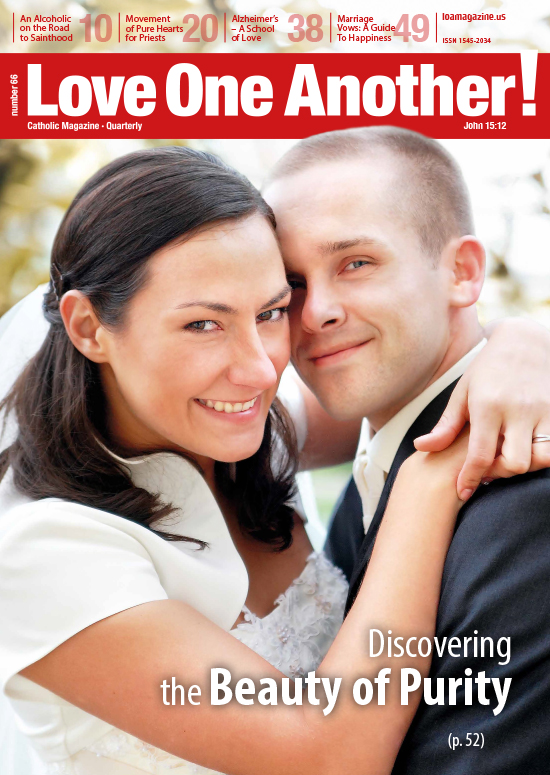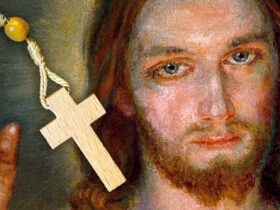Sin and Repentance in the Ancient Tradition

“There is only one misfortune: sin. Everything else is smoke and dust.” These words of St. John Chrysostom of the fourth century AD illustrate the view of the ancient Christians concerning the harm rejection of God wreaks both on human souls and the world at large.
From the very beginning, adherents of Christ faced a clear and simple choice: to stand either for God or for Satan. The Didache and Letter of Barnabas, Christian writings of the first and second centuries, spoke clearly of two paths: one was the path of life and light, the other of death and darkness. Tertium non datur (there is no third possibility). A Christian, in order to be worthy of that name, had to renounce everything that led to sin. “But the way of death is this. First of all it is evil and full of curse; murders, adulteries, lusts, fornications, thefts, idolatries, witchcrafts, sorceries, robberies, false witnessings, hypocrisies, double-heartedness, deceit, pride, wickedness, self-will, covetousness, filthy-talking, jealousy, presumption, haughtiness, boastfulness. Persecutors of the good, hating truth, loving a lie, not knowing the reward of righteousness, not cleaving to that which is good nor to righteous judgment, watchful not for that which is good but for that which is evil; far from whom is meekness and endurance, loving vanity, seeking after reward, not pitying the poor, not toiling with him who is vexed with toil, not knowing Him that made them, murderers of children, destroyers of the handiwork of God, turning away from the needy, vexing the afflicted, advocates of the rich, lawless judges of the poor, wholly sinful. May ye, children, be delivered from all these” Didache V. 1-2).
The Didache, written most likely toward the end of the first century, and thus almost contemporary to the New Testament, testifies admirably to the continuity and constancy of the moral teaching handed down by the Church. The ancient Christian writers subsequently developed the Church’s traditional teaching on sin and ways of combating it. The desert fathers especially took great pains to discern the origins of evil in the heart of man. Their observations allowed them to identify a number of temptations or “evil thoughts” (also called “passions”), which, coming from outside of man, poisoned his heart. Calling them simply “demons,” Evagrius of Pontus of the fourth century identified eight different kinds: gluttony, impurity, greed, anger, sadness, sloth, vanity, and pride. The catalogue is very close to the seven capital sins as taught by the Catholic Church.
The aim of a monk training himself in Christian perfection was to achieve a state of apathea, i.e. a passionless state in regard to sin, which Evagrius also called “purity of heart.” It consisted in freeing oneself from the influence of each demon and refraining from sins committed in deed and thought. According to Evagrius, this purity of heart was man’s natural state, his normal state of spiritual well being. Only those who were freed from inordinate and abnormal attachment to created things could be happy. It was thus a matter of overcoming greater or lesser addictions and replacing them with virtues: in a word—holiness.
“My dearest brethren, let none of ye be deceived! The worst kind of sin is not knowing what sin consists in. All those who confess their sins can be reconciled with God through penance. No sinner is more deserving of pity than the one who has nothing to bewail.” Thus did St. Caesar of Arles admonish Christians to recognize the essence and evil of sin. The ancient writers were agreed in insisting that sin sprang not from the world or the body, but rather from man’s heart and will. Sin always arose from inside man, and only then was it externalized. Hence the importance of recognizing it in its early stages, so as to root it out as quickly as possible. The eastern ascetical writers generally identified five stages by which sin entered the soul.
1. First, it appeared in the form of a suggestion or image of a sinful deed; in this there was as yet no evil. The Egyptian hermits compared it to a wind that slipped though one’s fingers. 2. The second stage took the form of a dialogue, i.e. a lingering over a sinful thought. No decision had yet been made. This stage recalled the Biblical dialogue between Eve and the serpent. 3. When this inner dialogue began to take root in a man’s heart and persisted for a time, it provoked an internal struggle, which ideally ended in mastery of the temptation. 4. Unfortunately, this mastery was not always achieved and, after consenting to the sinful thought, the person decided to act on it, thereby committing an actual sin. 5. The last and fifth stage took the form of a habit or addiction arising as a result of frequent failures and remaining in a state of sin.
The ancient Christian writers did not stop at merely describing the process of sin and addictions entering the human heart. They also sought to understand it, so as to be able to struggle for a pure heart in every situation and at every stage. Man’s chief recourse in the spiritual fight against evil was prayer and constant vigilance of heart. Writing in Greek, the authors often pointed to the similarity of the Greek words prosoche (awareness) and proseuche (prayer), thus symbolically linking these two aspects of man’s relation with God. With the aim of effectively and quickly combating sinful temptations, Evagrius of Pontus drew up and arranged a list of Scriptural verses to be used as ejaculatory prayers. The monks learned these by heart and uttered them at appropriate moments according to the kind of temptation. In the event one forgot these, uttering the name of Jesus was considered a sure way of fending off every evil—this in accordance with the Biblical promise, “Everyone shall be saved who calls on the name of the Lord” (Acts 2: 21). Ascetically experienced hermits held that constant prayer and awareness of the presence of God united with a sense of humility were the best weapons against attacks of the devil.
But even monks on occasion fell into sin. In that event, the ancient writers recommended immediate confession of their sins. Often they compared penance to medical intervention. Aphraates the Persian, living in Mesopotamia during the fourth century, vividly compared the sinner to a wrestler or a soldier who was wounded in battle. If he hid the wound and failed to show it promptly to the surgeon, gangrene would set in, causing death. St. Caesar of Arles of the fourth century imparted similar advice: “When the patient shows solidarity with his physician, the two of them conquer the disease. When the patient cleaves to his disease more than to his physician, than because there are two of them, the physician is beaten. But after this victory, the patient dies. If the patient cleaved to the physician, he would escape the passing disease, for in no way could the disease prevail over two opponents.
Pay heed to why I put this analogy to you. The physician is God; the patient is man, and the disease sin. When the sinner cleaves to God, the true physician, the disease passes at once, and the patient is freed from it. If, on the other hand, the wretched sinner loves his disease, then he prefers to cleave to his sins—a deadly disease—rather than his heavenly physician. Not only does he not complain of his disease—his sin—but he also shamelessly and with haughty brow strives to defend it. In cleaving to his sins, it seems he has beaten the heavenly physician. But by way of this wretched victory, he goes down, as it were, the broad and pleasant road to Gehenna. If, on the other hand, he wants to reconcile himself with his physician, then, by conquering sin (which is like the cruelest disease), he will gain admittance to heaven by the strait and narrow road.”
St. Augustine considered the forgiveness of sins to be a far greater miracle than the Creation. But this was always accomplished with man’s cooperation. St. Cyril, Bishop of Jerusalem in the fourth century, expressed this as follows: “Sin, then, is a great evil, but not so great as to be impossible to put right. Sin is a heavy burden for him who bears it, but a light one for him who, discharges it through penance. Imagine someone with a burning coal in his hand. It burns him for as long as he holds it. The moment he drops it, he relieves himself of that which is hell.”
Confessing one’s faults was therefore the easiest and surest way of removing the burden of sin and addiction. The tenth century Armenian poet, St. Gregory of Narek, wrote a work glorifying the words “I have sinned” in which man confesses his fault while seeking the grace of forgiveness. He called them “sisters of Baptism,” “blessed words capable of changing the last judgment.” Let us therefore make full use of these words, remembering that Christ’s mercy was intended first of all for the tax collectors and prostitutes, who understood their addiction to sin and sought to free themselves from it. The fifth century Syrian poet Cyrillonas admirably conveyed this in his “Song of the Conversion of Zacheus”:
“The more Zacheus feared, / The less he dared to ask for mercy. / The more the Lord grieved for him, / The more merciful He was toward him.”
Thus nothing has changed over the course of two thousand years. Human beings are just as subject to temptation, just as disposed to dialogue with Satan, or to be deceived, or to fall into sin. Nor has God’s attitude to sin changed, for God desires to help us to preserve our purity of heart, persevere in the face of temptation, and to raise us up from sin. Just as before, He desires the conversion of sinners that He may forgive them all their faults. He awaits every sinner, even the greatest, in the confessional. He does not seek to break the bruised reed, or to quench the wavering wick (cf. Is 42: 2-3). He knows our frailty and is full of mercy towards us.






